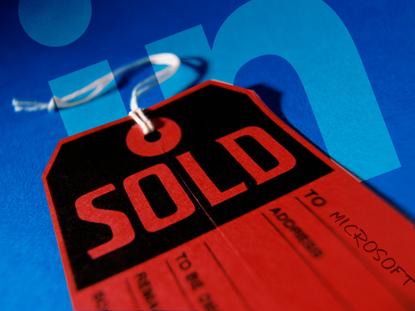Microsoft and LinkedIn aim for ‘logical’ integrations
- 10 December, 2016 01:35

Microsoft’s $26.2 billion acquisition of LinkedIn has officially closed, and the CEOs at both companies are sharing some of the early plans for integration across product lines.
The largest deal in Microsoft’s 41-year history will combine the “world’s leading professional cloud and the world’s leading professional network,” Microsoft CEO Satya Nadella wrote in a blog post. Both companies share a common mission to “help professionals transform how they work, realize new career opportunities and connect in new ways,” he added.
During the coming months, LinkedIn and Microsoft say they will be integrating products, especially in areas where Microsoft’s scale can be an asset. Nadella and LinkedIn CEO Jeff Weiner spotlighted eight areas the companies are going to pursue immediately:
● LinkedIn identity and network in Microsoft Outlook and the Office suite
● LinkedIn notifications within the Windows action center
● Enabling members drafting resumes in Word to update their profiles, and discover and apply to jobs on LinkedIn
● Extending the reach of Sponsored Content across Microsoft properties
● Enterprise LinkedIn Lookup powered by Active Directory and Office 365
● LinkedIn Learning available across the Office 365 and Windows ecosystem
● Developing a business news desk across our content ecosystem and MSN.com
● Redefining social selling through the combination of Sales Navigator and Dynamics 365
The initial integrations seem sensible, relatively straightforward, and represent a “logical list of early to-dos to be focusing on as the two companies become integrated,” says Jan Dawson, chief analyst and founder of tech research firm Jackdaw. “Some of this is particularly simple and can probably happen very quickly, while other elements will be longer-term projects.”
[ Related: Microsoft’s big bet on LinkedIn not just about data ]
Dawson says he expects the companies to do more work around the social component of LinkedIn, especially as it relates to business collaboration and communication. “Yammer has been Microsoft’s work social network, but that’s fading in the face of competition from Slack and others, so I’d have hoped to see a bit more here,” he says. Microsoft’s recently launched Teams collaboration app for enterprise could also play a big role as the companies move forward to combine the best aspects of their products.
The ‘most compelling reason’ for LinkedIn acquisition
Raul Castanon-Martinez, senior analyst at 451 Research, says the integration of LinkedIn’s Sales Navigator and Microsoft’s CRM tool, Dynamics 365, was the most compelling reason for the acquisition. The development of a business news desk is somewhat of a surprise, however, but it should extend Microsoft’s reach for sponsored content on LinkedIn, he says.
Castanon-Martinez also expects Microsoft to further embed access to LinkedIn’s data to provide and enrich context for user engagement across Microsoft applications. “Microsoft has been very vocal this year about how it will use machine learning and artificial intelligence to support the ways in which employees get work done,” he says. An important component is providing the context for these activities and tasks... There is a wealth of information that could be extracted from LinkedIn to provide the context for these activities.”
[ Related: Microsoft Teams targets Slack in crowded collaboration market ]
The combination of LinkedIn and Microsoft is going to be most valuable for people who use products from both companies, according to Dawson. “They’re obviously hoping to drive interest in both Microsoft software and LinkedIn memberships among those who don’t have one or the other today, but it’s not like either platform suffers from a lack of awareness,” he says.
LinkedIn and Microsoft leadership teams have been meeting regularly during the past six months to prioritize the opportunities ahead, Weiner wrote in a blog post. “We’ve been able to see first-hand the level of innovation being driven at scale -- in artificial intelligence, machine learning, the cloud, devices and more,” he wrote. Day-to-day operations at LinkedIn will remain unchanged, according to Weiner. “We’ll continue to have the same mission and vision, the same culture and values, the same brand, and the same leadership team.”

